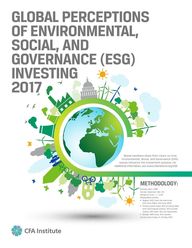
Return to flip book view
GLOBAL PERCEPTIONS OF ENVIRONMENTAL SOCIAL AND GOVERNANCE ESG INVESTING 2017 Global members share their views on how Environmental Social and Governance ESG issues influence the investment process For additional information see www cfainstitute org ESG METHODOLOGY Sample size 1 588 Survey response rate 3 Margin of error 2 4 Respondent profile Region 64 from the Americas 23 from EMEA 13 from APAC Primary asset base 42 primarily deal with institutional clients 30 private clients 18 both 10 not applicable Gender 84 men 16 women Survey time frame 9 23 May 2017
HOW ESG INFLUENCES THE INVESTMENT PROCESS Client demand is the primary driver in ESG investing with most respondents saying they would consider ESG if there was sufficient demand Although those considering ESG remains the same overall there has been growth in the use of each component 73 45 51 CONSIDER ESG ISSUES ONLY OCCASIONALLY TAKE ESG ISSUES INTO ACCOUNT SAME AS 2015 20 0 40 60 0 100 80 47 40 WHO DON T USE ESG CITE LACK OF CLIENT DEMAND 60 AS THE REASON 80 20 54 50 54 49 2015 2017 2015 2015 20 2017 2015 27 40 27 2017 80 I DO NOT TAKE ESG FACTORS INTO CONSIDERATION 65 63 2015 45 44 66 76 LISTED EQUITY GOVERNANCE Risk analysis and client demand were the main reasons to take ESG integration into consideration 2015 100 TO HELP MANAGE INVESTMENT RISKS CLIENTS INVESTORS DEMAND IT TAKE ESG ISSUES 100 INTO ACCOUNT SYSTEMATICALLY 80 Of those that practice ESG integration it is more commonly done with equities versus fixed income SOCIAL 60 2017 60 OF THOSE THAT DON T CURRENTLY USE ESG FACTORS WOULD IF THERE WAS DEMAND FROM CLIENTS UP 9 FROM 2015 ENVIRONMENTAL 67 64 2017 40 SAME AS 2015 There has been growth in the use of each E S and G 2017 20 100 FIXED INCOME 45 use of ESG in60 the investment 0While the most 20 common 40 80 process is still integrating it into the whole investment analysis and decision making process there was an uptick in exclusionary screening that was offset by a slight decrease in best in class investing since 2015 59 57 2017 2015 2017 2015 2017 2015 38 36 33 38 COMPLETE ESG INTEGRATION EXCLUSIONARY SCREENING BEST IN CLASS INVESTING POSITIVE ALIGNMENT When examining ESG investing practices the most impactful issues are 77 BOARD ACCOUNTABILITY 65 62 HUMAN ENVIRONMENTAL CAPITAL DEGRADATION 0 100
Further the biggest factors that limit the ability to use non financial information include 55 Lack of appropriate quantitative ESG info 50 Lack of comparability across time 61 agree that public companies should be required to report on ESG indicators Same as 2015 45 Questionable data quality 50 now think it is necessary to have a high assurance audit quality independent verification process to verify ESG disclosures up 6 from 2015 Training in ESG is rare Only about one in three said employees receive training on ESG up from 28 in 2015 HOW ESG INVESTING VARIES ACROSS REGIONS Investment professionals in EMEA are most likely to take ESG issues into account in their investment analysis and decisions followed by APAC and lastly the Americas 68 85 68 81 85 68 85 81 81 0 AMERICAS 68 EMEA 68 Takes ESG into account AMERICAS 66 58 APAC AMERICAS EMEA APAC AMERICAS EMEA APAC 48 40 68 68 68 68 60 80 100 APAC Takes ESG into account 49 EMEA 20 65 63 61 ENVIRONMENTAL SOCIAL 74 81 A consistent theme among E Americas respondents across49 regions was EMEA 66 that client demand drives the issue APAC 58 of ESGS in the investment process G 6767 GOVERNANCE AMERICAS Americas 48 EMEA 65 APAC 63 61 61 Americas 61 EMEA 74 APAC 81 EMEA 6565 APAC Investment professionals worldwide also agree that ESG integration is the most effective strategy for using ESG factors 5959 6464 AMERICAS Respondents are much more likely to get ESG training in EMEA than in the Americas and APAC 28 43 30 EMEA 51 51 APAC
HOW DIFFERENT TYPES OF INVESTMENT PROFESSIONALS VIEW ESG INVESTING While institutional investors are more likely than private investors to take ESG into consideration 0the difference 20between portfolio 40 managers and analysts is less pronounced 60 80 100 GENERATIONAL DIFFERENCES Considers ESG in investment decisions INSTITUTIONAL INVESTORS 63 PRIVATE INVESTORS PORTFOLIO MANAGERS ANALYSTS 79 71 78 Younger generations are more likely to consider ESG Millennials 78 Gen X 74 Baby Boomers 68 GENDER DIFFERENCES Women are more likely than men to include ESG data in their investment process consider ESG issues in their investment analysis 46 men VS 18 say ESG issues are immaterial women or add no value to investment analysis or decisions Environmental 52 Social 53 Governance 67 62 60 68 Those who consider ESG in investing put different emphasis on the components 2017 CFA Institute All rights reserved 62 of women and 49 of men systematically